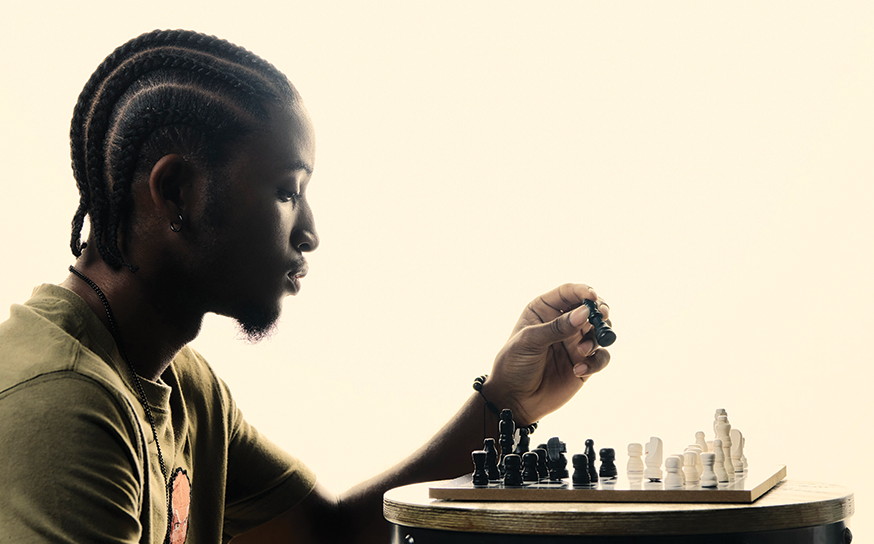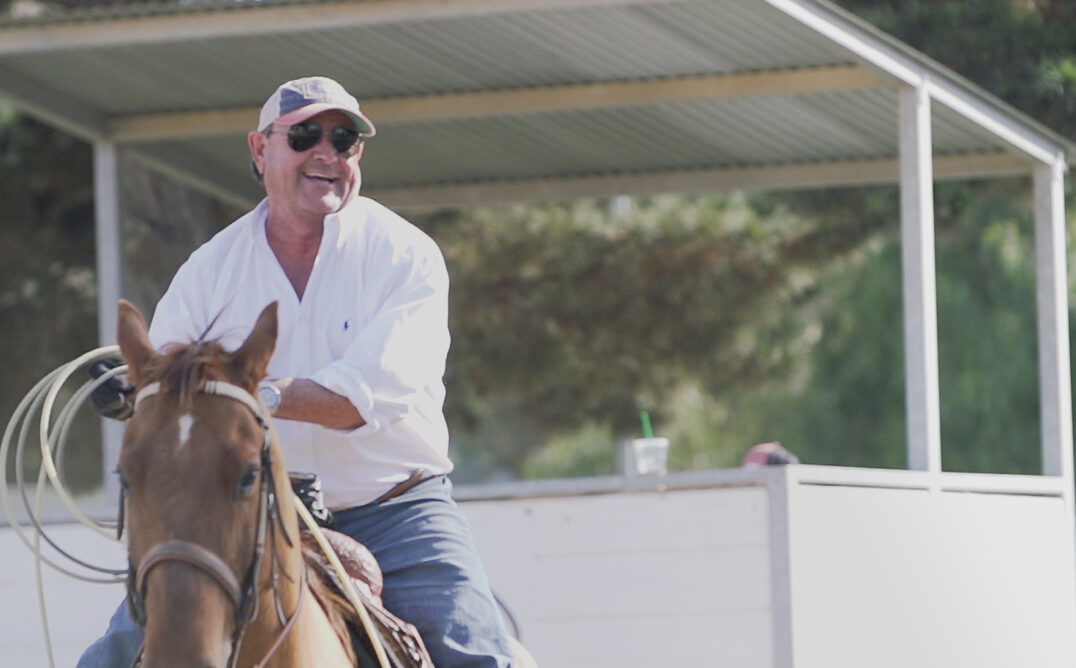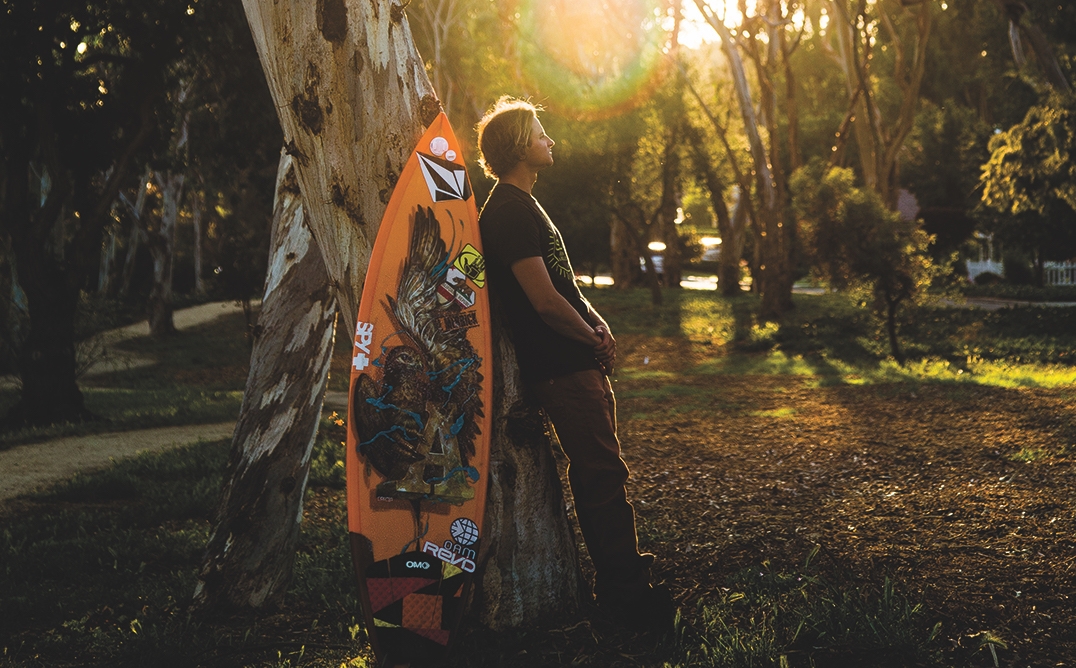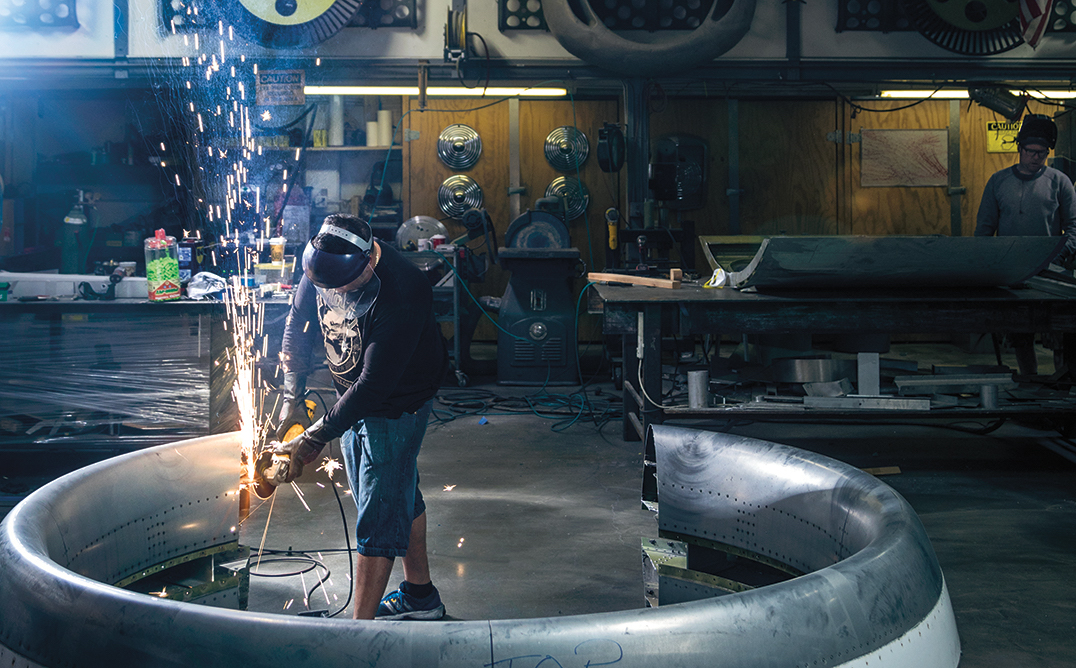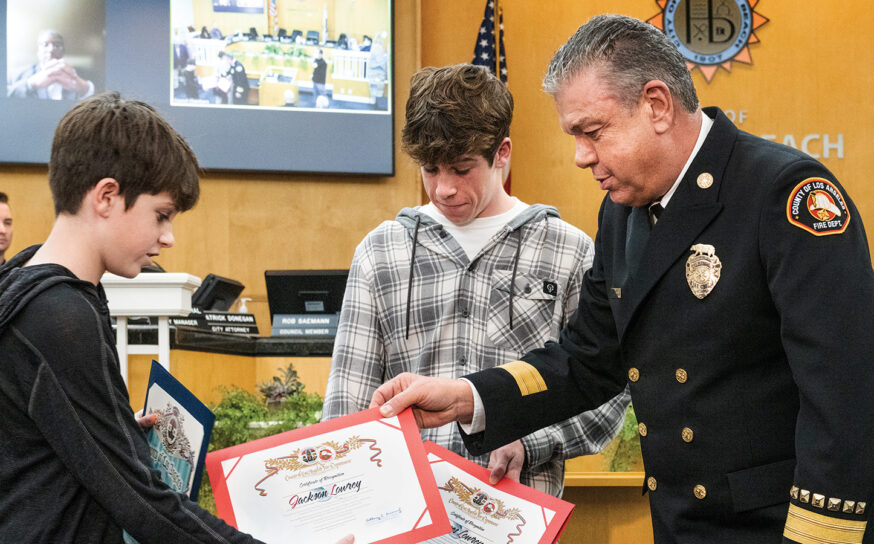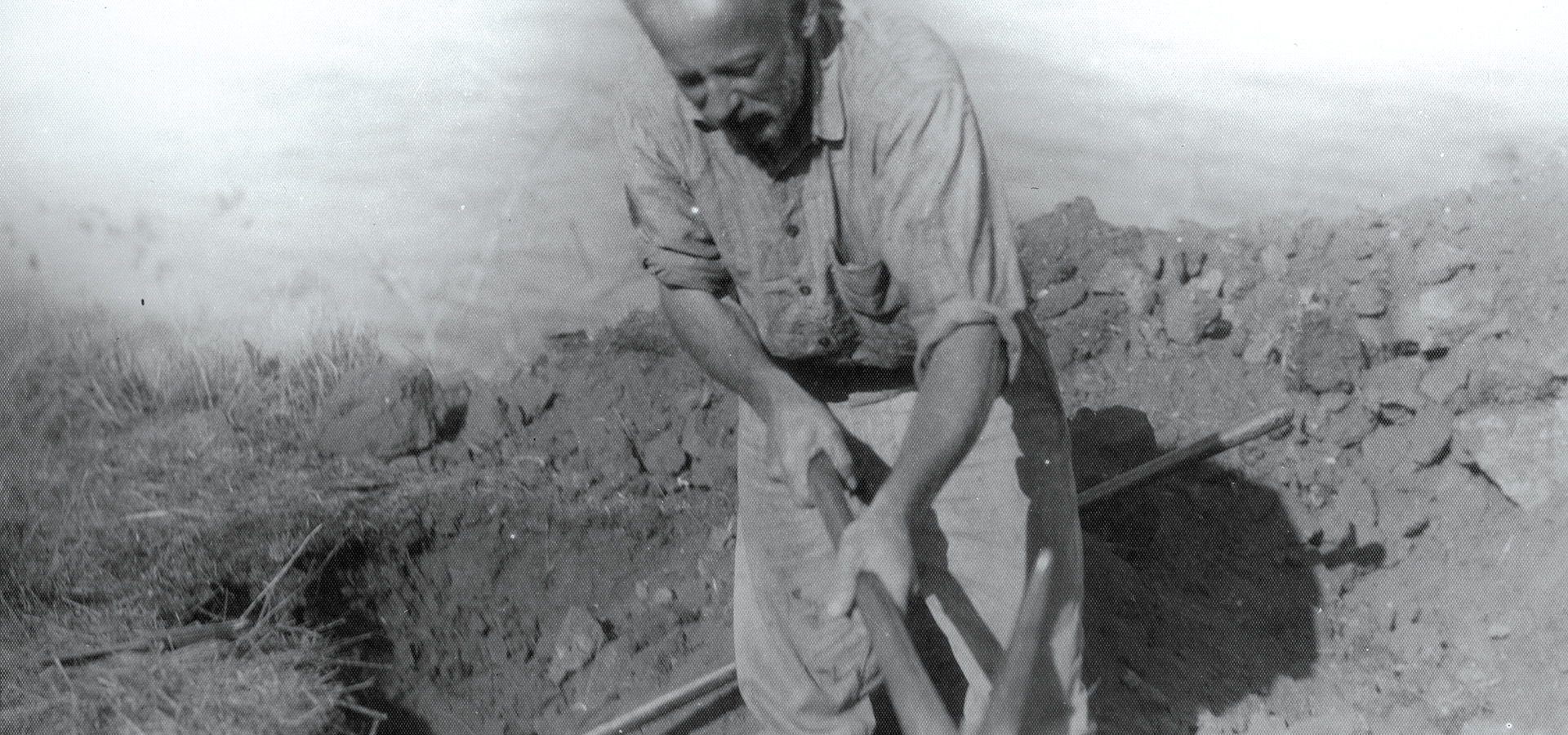
Was Ralph Glidden a self-made Indiana Jones or a grave-robbing huckster out to make a buck?
Tracing the Giants of Catalina.
- CategoryPeople
- Written byPeggy Jo Abraham
Most people accept the scientific belief that dinosaurs roamed the earth some 250 million years ago. We can learn about their existence and appearance through carefully preserved fossil skeletons. However this is not the case when it comes to the discovery of the so-called “giants of Catalina.”
A strange man named Ralph Glidden is behind this mysterious and unproven claim. Glidden, born in 1881, moved to Catalina Island when he was 15 years old. He was working as a carpenter 23 years later when he reportedly met a treasure hunter and began exploring the island. There is a story that he stubbed his toe on a human skull while looking for pearls.
Regardless of how he got started, Glidden did unearth human bones, along with artifacts like bowls and tools, while digging up ancient burial sites of the native Tongva Indians. Some say he dug up as many as 800 such sites. The Tongva tribe was known to have inhabited the Channel Islands 8,000 years ago.
Archeology as a formal discipline was in its infancy in the 1920s. There were no laws at the time to prevent Glidden’s destructive activity, and so people didn’t really question what he was doing.
According to an archeologist from the Fowler Museum at UCLA, “People did not have the same view of human remains that we do now. It was not uncommon for people to collect and trade bones, like we might do with baseball cards.”
Thus it wasn’t until many years later that people started recognizing Glidden for what he really was. Roy Rose, a resident of Catalina for 75 years, sums up Glidden’s character in much the same way that most people now view him: “He was a grave robber! He also misrepresented his credentials, was a thief and a liar.”
In the early days of Glidden’s digging, an organization on the East Coast called the Heye Foundation was amassing a collection of Indian artifacts from around the country. They hired him to do some excavation, despite the fact that he had absolutely no knowledge of archeological practices or procedures.
Glidden was, however, a natural self-promoter and actually hired a publicist (virtually an unknown practice at the time) to bring attention to his discoveries. The publicist fabricated his background and exaggerated his findings, calling Glidden a “professor” and even a “doctor” although he never graduated from high school. The stories gained some traction and appeared in various publications like Popular Science, The New York Times and The Boston Globe—giving a false sense of validation to his work.
About the same time that Glidden was beginning to garner a bit of recognition, a legitimate British archeologist and Egyptologist named Howard Carter became a worldwide celebrity for discovering the intact tomb of King Tut in 1922. The wave of publicity, the start of an Egyptian craze and Carter’s newfound fame annoyed Glidden. He needed to find a way to up his game and get back on people’s radar.
“He was a grave robber! He also misrepresented his credentials, was a thief and a liar.”
So not to be outdone, he started making up outrageous tales. Seemingly out of nowhere, Glidden made his grandest claim of all: that there had once been an ancient race of extremely tall, fair-haired, blue-eyed “giants” living on Catalina Island. He promoted the idea that he had found skeletons of these giants, ranging in height from 7 feet to 9 feet tall.
It’s important to note that there has never been any scientific evidence to substantiate this claim; neither the giant bones or pictures of the bones exist.
In a bizarre twist, Glidden was not the only one to make such a claim. In 1913 Dr. A.W Furstenan of Germany said he found the skeleton of what appeared to be an 8-foot tall human in Avalon Bay. Supposedly it was discovered in hard black sand and was mostly disintegrated when it was brought to the surface and exposed to air—leaving only the skull, jawbone and a foot intact.
Once again, there has never been any physical evidence to prove this.
Chicago chewing gum magnate William Wrigley Jr. purchased Catalina in 1919. He was interested in preserving the history of the island and put a stop to all unauthorized digging. Glidden was allowed to continue because of his contract, but about five years later he lost his funding from the Heye Foundation. It’s generally believed that he fabricated the “giants” story and other tall tales to create interest and make money.
It was then he came up with the idea of opening a “museum” to display the artifacts and skeletons he had looted. Glidden hoped that by charging admission, he could earn enough income to continue his work.

Named the Catalina Museum of Island Indians, the makeshift museum overlooking Avalon’s harbor was often described as bizarre and macabre. “The museum was modeled after an image he saw of a chapel in Malta,” says Gail Fornasiere, director of marketing and public relations at the Catalina Island Museum, which today is the only institution dedicated to the arts, culture and history of Santa Catalina Island. “This chapel was made by the monks using the bones of the other monks. When opening his museum, Glidden said he wanted to have something North America had never seen before.”
Glidden’s creation was definitely something no one in the area had seen before. He incorporated bones he’d found into the architecture of his structure, using them for both support and decoration. Skull-filled shelves were held up by arm and leg bones serving as brackets. Window frames were adorned with toe and finger bones—the whole scene exhibiting a complete disregard for American Indians and their culture.
Not only were there questions about Glidden’s fantastic claims, there were also suspicions that he was collecting remains from all over the world and passing them off as discoveries native to Catalina. Some archeologists have surmised Glidden purchased bones of people who were Incan, African and Egyptian and exhibited them as Indian relics.
Roy Rose remembers paying a quarter to go inside the museum. “I brought my younger brother up with me and we wanted to have a look at this place, and it was very spooky. I told my brother, ‘This place really smells funny.’ And out of nowhere Mr. Glidden appeared and said, ‘Young man, this place doesn’t smell any funnier than your house does,’” he recalls.
Glidden’s weird and creepy museum did not prove as lucrative as he’d hoped. While his earnings shrunk, his tales grew—becoming more and more far-fetched. He claimed to have evidence of “white Indians” and even to have discovered the fabled lost Temple of the Sun God, which was said to be larger than Stonehenge.
There was also the grandiose story of a soapstone funerary urn with the skeletal remains of a “royal princess.” She supposedly was clutching the brim of the urn and surrounded by the skeletons of 64 children. Again, there are no known photographs of the “princess” or the skeletons. However a 138-pound urn was discovered and became an attraction at Glidden’s museum, which closed in 1950.
Over time, the property was passed on to the present owners who built the Seaport Hotel on the site.
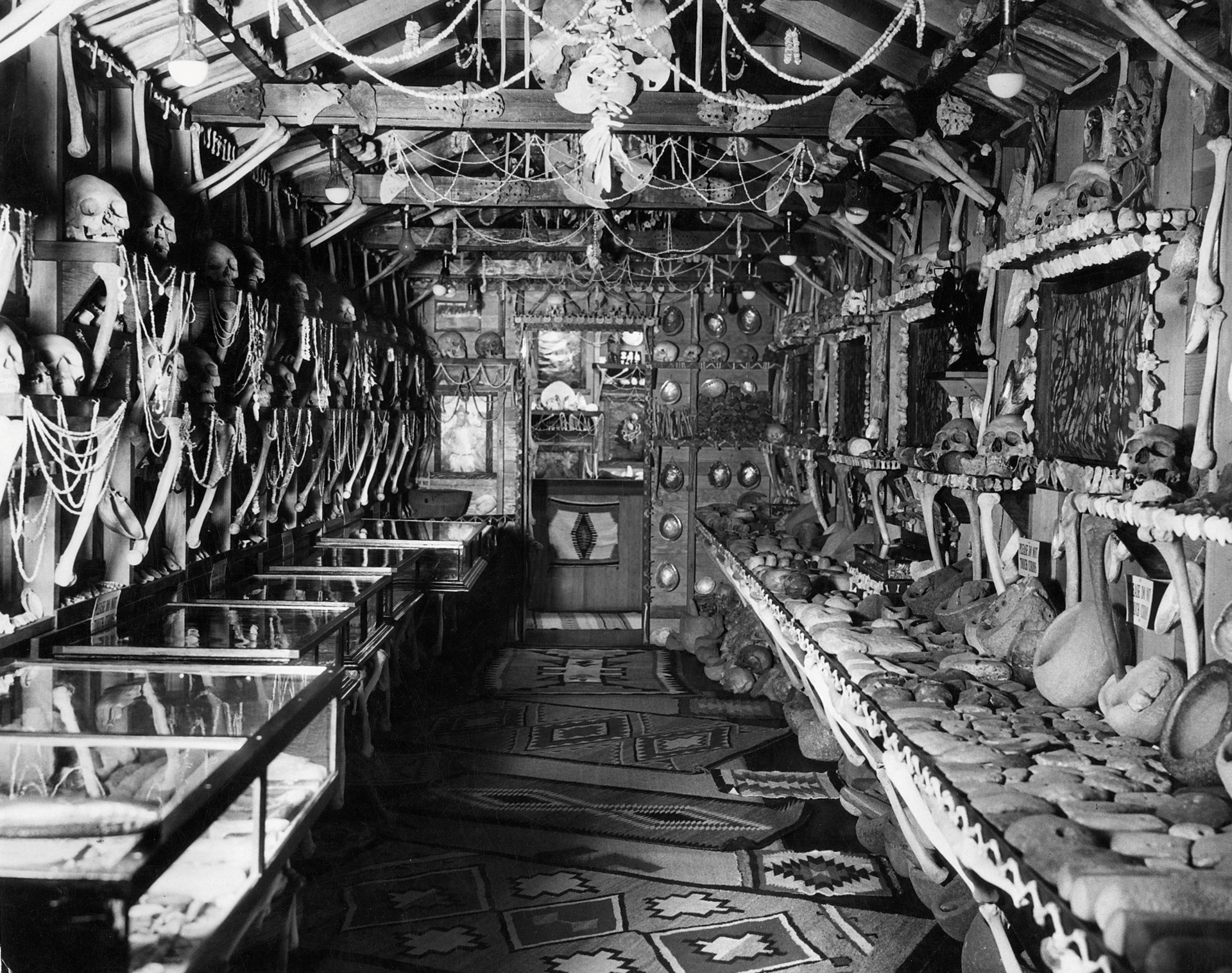
Shortly after Glidden’s death in 1968, Philip K. Wrigley, the son of William Jr, bought Glidden’s entire collection for $5,000 and donated it to the Catalina Island Museum. Today the museum houses the artifacts, journals, photos and scrapbooks of newspaper clippings that Glidden saved.
Six years ago the museum held an exhibition titled “The Strange and Mysterious Case of Dr. Glidden.” In addition to the artifacts, the museum was also in possession of human remains. A federal grant enabled the Catalina Island Museum to work with UCLA to repatriate the remains back to the island. There was a ceremony in 2016 to mark the occasion when the remains were reburied in an undisclosed location.
Through the years there has been occasional outside interest in the giants. Four years ago the museum worked with the History Channel for a series called Search for the Lost Giants. “The hosts of the show went through our permanent collection and determined that Ralph Glidden’s claims of giants were not correct. Though he had notes and photographs from most of his excavations, there was no proof he ever discovered giants,” says Fornasiere.
These days, although the museum does not believe that any of Glidden’s claims about the giants are credible, they understand his story is part of the island’s history. Fornasiere says it is unfortunate that they don’t know as much as they could have about the Indians who lived there.
“Because Glidden took it upon himself to excavate as many native islander sites as possible and he was not a trained archaeologist, we know very little about the island’s natives. If these sites had been properly studied by professional archaeologists, we feel we would have a better understanding of their life and daily activities. We only know what he claimed and what he found with his pick-axe,” she explains.
Glidden was always seeking attention and wanted to be remembered as an amazing relic hunter, but he died penniless and basically unknown. Catalina Island has a history of fascinating characters, and he is certainly one of these. Despite his lifelong quest for fame and notoriety, it seems Ralph Glidden died as a true legend only in his own mind.
Southbay ‘s Annual Spring Style Guide Has the Latest Fashion Trends, Jewelry, Home Goods and Gifts!
Shop local and support our amazing businesses.







